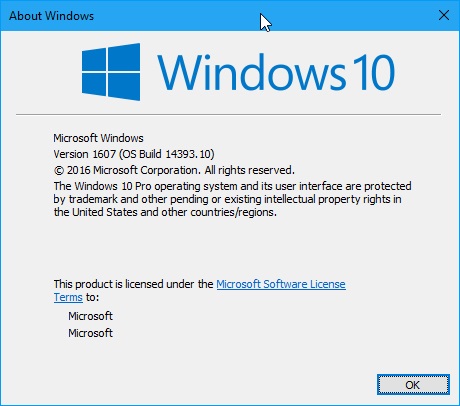Latest Windows Updates and Service Packs overview
This guide provides you with information on the latest Windows updates and Service Packs, including where to download them and how to install them.
Microsoft released service packs traditionally for its operating systems, but switched to the new feature upgrade system with the release of Windows 8.
Service Packs are only available for Windows 7 and earlier operating systems on the client side, while Feature upgrades for Windows 8 and newer versions of Windows including Windows 10.
Windows Support
Microsoft supports the following client operating systems currently:
| Operating system | Latest Update | Support Phase | End of Support |
| Windows XP | Service Pack 3 | ended | ended |
| Windows Vista | Service Pack 2 | extended support | April 11, 2017 |
| Windows 7 | Service Pack 1 | extended support | January 14, 2020 |
| Windows 8 | Windows 8.1 | mainstream support | January 9, 2018 |
| Windows 8 | Windows 8.1 | extended support | January 10, 2023 |
| Windows 10 | Anniversary Update | mainstream support | October 13, 2020 |
| Windows 10 | Anniversary Update | extended support | October 14, 2025 |
Windows 10 support may be extended beyond the dates currently provided.
Major Windows Updates

Generally speaking, there won't be any new major updates for any version of Windows but Windows 10. Microsoft won't release Windows 8.2 for instance, and it won't release Service Packs anymore either.
The company plans to release two feature updates for Windows 10 per year.
| Windows 10 version | Name | Release date |
| Windows 10 build 1507 | initial release | 29.07.2015 |
| Windows 10 build 1511 | November Update | 12.11.2016 |
| Windows 10 build 1607 | Anniversary Update | 2.08.2016 |
| Windows 10 build 1704 | Creators Update | April 2017 |
| Windows 10 build 17xx | unknown | Late 2017 |
Service Packs Downloads
The following table lists Windows client and server operating systems, and the most recent Service Pack or Feature upgrades for each.
Download links may point to the Microsoft Update Catalog for standalone downloads, to the Microsoft Download site, or tools that help you download these updates.
Please note that you may use Windows Update as well to download the latest updates, service packs and feature upgrades for the version of Windows that is installed on the computer.
| Windows Version | Architecture | Service Pack | Size | Download |
| Windows XP | 32-bit | Service Pack 2 | 266.0 MB | SP2 32-bit |
| Windows XP | 32-bit | Service Pack 3 | 316.4 MB | SP3 32-bit |
| Windows XP Pro | 64-bit | Service Pack 2 | 350.9 MB | SP2 64-bit |
| Windows Vista | 32-bit | Service Pack 1 | 544.3 MB | SP1 32-bit |
| Windows Vista | 64-bit | Service Pack 1 | 873.0 MB | SP1 64-bit |
| Windows Vista | 32-bit | Service Pack 2 | 475.5 MB | SP2 32-bit |
| Windows Vista | 64-bit | Service Pack 2 | 745.2 MB | SP2 64-bit |
| Windows 7 | 32-bit | Service Pack 1 | 537.8 MB | SP1 32-bit |
| Windows 7 | 64-bit | Service Pack 1 | 903.2 MB | SP1 64-bit |
| Windows 7 | 32-bit and 64-bit ISO | Service Pack 1 | 1.9 GB | SP1 ISO |
| Windows 7 | 32-bit | Convenience Rollup | 316.0 MB | CR 32-bit |
| Windows 7 | 64-bit | Convenience Rollup | 476.9 MB | CR 64-bit |
| Windows 8 | 32-bit | Windows 8.1 | 428.9 MB | W8.1 32-bit |
| Windows 8 | 64-bit | Windows 8.1 | 887.9 MB | W8.1 64-bit |
| Windows 10 | 32-bit and 64-bit | Anniversary Update | depends | W10 1611 |
| Windows Server 2003 | 32-bit | Service Pack 2 | 372.0 MB | SP2 32-bit |
| Windows Server 2003 | 64-bit | Service Pack 2 | 350.9 Mb | SP2 64-bit |
| Windows Server 2008 | 32-bit | Service Pack 2 | 475.5 MB | SP2 32-bit |
| Windows Server 2008 | 64-bit | Service Pack 2 | 745.2 MB | SP2 64-bit |
| Windows Server 2008 R2 | 64-bit | Service Pack 1 | 912.4 MB | SP1 64-bit |
| Windows Server 2008 R2 | 64-bit | Convenience Rollup | 476.9 MB | CR 64-bit |
Some notes:
- Service Pack updates are cumulative usually. This means that you only need to install the latest available Service Pack and not previously released ones. Exception: Windows Vista requires SP1 before you can install SP2. Windows XP requires SP1a or SP2 before you can install SP3.
- There is no Windows XP Pro 64-bit Service Pack 3.
- There is no 32-bit version of Windows Server 2008 R2.
- The Convenience Rollup update for Windows 7 and Windows Server 2008 R2 requires the April 2015 servicing stack update.
- Windows 10 feature upgrades are cumulative as well. You only need to install the latest to install all available feature upgrades.
This article was first seen on ComTek's "TekBits" Technology News

- Log in to post comments